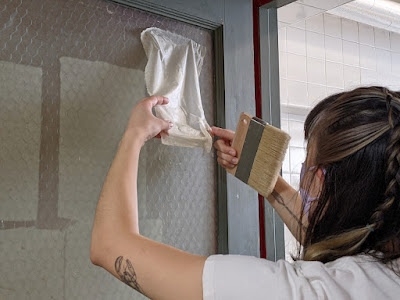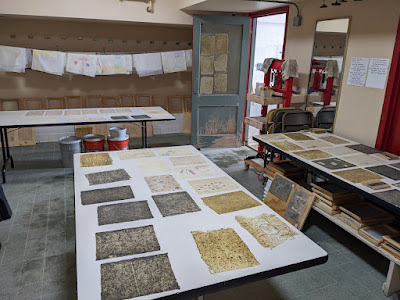I was alarmed to find that a fridge had appeared next to the classroom, taking up the outlet that I always used for cooking, so after pots failing to come to a boil, I ran out at lunch to buy a new burner and then separated the two and had a pot in the hallway and another in the classroom. It meant that I had to stay 2.5 hours after the students left to watch the pots (miraculously, security did not even bat an eye at a pot boiling on the floor in the hallway that has a giant leak in the ceiling). The next day, they did a bunch of rinsing.
Unlike past classes where I show too much mercy with beating times, I made them beat for almost an hour. In the interim, I realized I needed to slip out to grab my lunch so that I could sit with the pots on Day Two, since leaving for lunch and turning off the heat was not going to be helpful.
I gave them all earplugs and our two taller students beat in the loudest room. Naturally, they were exhausted and happy to leave for lunch.
I was impressed by how well they took to papermaking that afternoon. There was no rushing or pushing to make a lot, instead a lot of curiosity about how it worked, why certain things were happening: a wrinkle, a clump, a failure to release.
This is the first group I've had where almost every single student has come to me to ask about what is going wrong, what is preventing them from having a pristine sheet.
I don't know if it's because they feel a need to be perfect, or if it's because they want to learn technique well, or if because they believe that I can help them.
Whatever the motivation, it's incredibly gratifying to have a group unafraid to approach me and to ask questions. Not only about technique but a lot of other big questions.
They also have a lot of ending up in tandem, which is always fun.
This is the first year I got a couple extra chip brushes, not as good as these wonderful 6-inch wall brushes, so that everyone can board simultaneously. Mostly I'm learning that my initial idea to have all different tools so that there are lots of options was not the best, as students simply want to have equal tool access or to all be working at the same baseline. But tool nuances feel so important to me; that's how teachers impose their own agenda.
The next day I was SHOCKED by how attentive they were to sorting and curating and cleaning paper and pellons. I mean, no other class has been this willing to do this much work. Then again, I suspect they were extremely tired by all the beating and physical work so they were happy to sit and focus on one dry thing right in front of them.
They were so careful in removing dry paper even though I tried to demonstrate that the sheets are not as delicate as they might imagine.
We had almost 70 sheets and probably over 100 pellons. They cleaned everything. And no whining! In fact, I had made this optional but they all just sat down and did it.
We had one intrepid student make some bark lace, which is always a delight.
Because I could tell they were doing this to avoid beating, I had them pick fiber until lunch instead. I have never had the entire class go completely silent for so long. What gorgeous focus. One student asked at the end of the day today if this was my quietest class. Maybe!
Look at how precisely she is working, can you see what she's up to?
Removing that one speck of bark.
This always happens to beginners but I was glad to see some of them not give up and work through the challenges. I also overpressed a bit, weighing the chances for more potato chip paper (pulls away too quickly from the surface while drying to shrink and cockle unevenly) versus more ease in boarding.I had to have this photo staged because they were about to climb out of this little spot on top of the table. I really wish I could configure this classroom more ergonomically well but it's a hard space to configure.
The second batch of dry paper, instead of paper mulberry grown in Thailand, was the same species grown in Florida. Lovely stuff. Both batches were great and the first was surprisingly so much better than I feared, even after all the cooking issues.
This is a great window to dry onto but it's just hard to get to. I'm glad that more students than in the past are completely unafraid to climb tables.
Today I knew they dreaded beating for the third day in a row, but promised that they would never have to beat fiber for another day in their lives if they so pleased. The front batch is milkweed, the back batch is scraped waste from Florida paper mulberry.
We had plenty of fiber left over from the previous day, even after pulling over 80 sheets, so I had them set up four fibers on four tables, two vats each.
They were so happy to be "creative" today, meaning that instead of pulling plain sheets that they didn't label with their own names, they were able to embed all kinds of things, do water soluble transfers, and play with different types of fibers in one sheet.
They immediately got to that kind of work and all I wanted to do was hug them for unleashing those explorations. One day I overhead talking about TV series, but today I heard them sharing what books they were reading with each other and was so delighted to find, upon asking, that they still read real live books with paper pages.
We had lots more paper, working until we ran out of pellons, and nearly ran out of surfaces to dry onto.
I didn't even have to tell them to clean and dry this table to open it for sheets. I talked to one student about how she ended up at Oberlin and it went into a whole journey that ended in wanting to study later with Robin Wall Kimmerer. Another student added that they had also read and loved Braiding Sweetgrass and it made my heart sing.
There are more sheets to the left and in the back room and whew! We survived Week One. A student came to me at the end of the day to say how much fun it was and would we get to do more next week? Prepping for this class with less than a week from my return from Virginia in endless snow and shoveling was brutal; often while going from home to studio and back, making orders, and doing admin, I'd wonder why I do this to myself. Somehow I feel like I am working through my karma by teaching, which is endlessly revealing and pushes me to excavate my worst and best selves. I am insanely sleep deprived and and wrung out yet grateful to be back to this place I have known and loved for over 25 years.
If you want to see how tired I am, register to watch my talk with Steph Rue for the SDA online conference tomorrow!
But better yet, watch Robin Wall Kimmerer reveal the stories of the land. Thanks to Velma for sharing the wonderful video with me.































2 comments:
When it works, there is absolutely no better experience in the world. (And when it works, it's because the teacher and the students have brought their full selves to the work. Thank you for doing that, always.)
The concentration is impressive, as is your ingenious use of the space! Look forward to seeing more.
Post a Comment